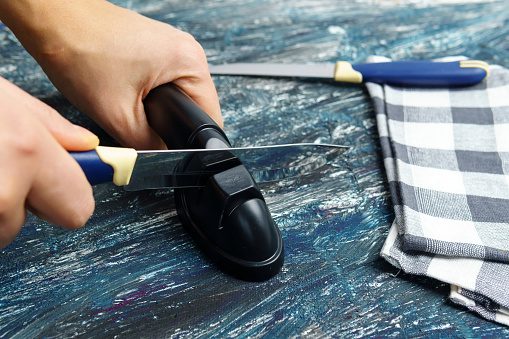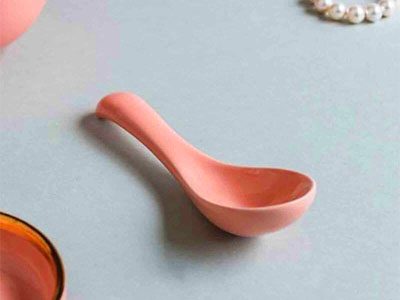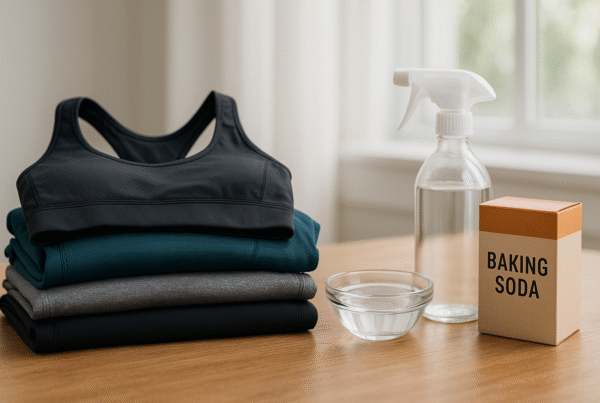Sharp And Efficient – Top 5 Best Kitchen Knife Sharpeners of 2023

Hey there! If you’re anything like me, you know how frustrating it can be to try and chop vegetables with a dull kitchen knife. Not only does it make meal prep take longer, but it can also be dangerous! That’s why I’ve scoured the internet and tested out various kitchen knife sharpeners to bring you the top 5 best kitchen knife sharpeners in 2023. With these sharpeners, you’ll be able to keep your blades razor-sharp and ready to handle any culinary task with ease. So, let’s dive in and find the perfect kitchen knife sharpener for you!
Read More: Can you put sharp knives in the dishwasher?
The Importance of Knife Sharpening
A sharp knife is not only crucial for achieving precision cuts but also plays a significant role in ensuring the safety and efficiency of kitchen operations. A sharp knife allows chefs and cooks to maintain better control over their cuts, reducing the risk of slips and accidental injuries. When a knife is dull, it requires more force to cut through ingredients, increasing the chances of the knife slipping and causing harm. By regularly sharpening knives, kitchen staff can minimize the likelihood of accidents and promote a safer working environment.
Moreover, a sharp knife significantly enhances efficiency in the kitchen. A dull knife not only slows down the food preparation process but also compromises the quality of the cuts.
Furthermore, a dull knife can also impact the flavors of the food being prepared. When ingredients are not properly sliced, their cellular structure is disrupted, causing them to release more juices and lose their natural flavors.
Types of Knife Sharpeners
When it comes to maintaining the sharpness of your knives, there are several types of knife sharpeners available in the market. Each type offers its own set of advantages and disadvantages, catering to different needs and preferences. Let’s explore the three main types of knife sharpeners: manual sharpeners, electric sharpeners, and sharpening stones.
⒈ Manual Sharpeners

Image Credit-Amazon
Manual sharpeners are the most traditional and widely used type of knife sharpeners. They typically consist of a handle and a sharpening surface, which can be made of ceramic, diamond, or tungsten carbide. One of the key advantages of manual sharpeners is their simplicity and ease of use. They are portable, affordable, and require minimal maintenance. However, manual sharpeners may not be suitable for beginners, as they require some skill and technique to achieve optimal results. Additionally, they may not be as effective in sharpening severely dull or damaged blades.
⒉ Electric Sharpeners

Image Credit-Amazon
Electric sharpeners are a popular choice among professional chefs and avid home cooks. These sharpeners feature motorized grinding wheels or belts that quickly and efficiently sharpen the blades. One of the main advantages of electric sharpeners is their speed and convenience. They can sharpen knives in a matter of minutes, saving you valuable time in the kitchen. However, electric sharpeners tend to be more expensive than manual sharpeners and may require more storage space. They also have a higher risk of overheating the blade if not used properly, which can damage the tempering of the steel.
⒊ Sharpening Stones

Image Credit-Amazon
Sharpening stones, also known as whetstones, have been used for centuries to sharpen knives. They come in various grit levels, ranging from coarse to fine, allowing you to choose the level of sharpness you desire. One of the main advantages of sharpening stones is their versatility. They can be used to sharpen a wide range of knives, including those with serrated edges. Sharpening stones also offer precise control over the sharpening process, allowing you to customize the angle and pressure according to your preferences. However, using sharpening stones requires practice and patience, as it can be time-consuming and labor-intensive. They also require regular maintenance and cleaning to ensure optimal performance.
1. KITCHELLENCE Best Kitchen Knife Sharpener
The Kitchen Knife Sharpener and Cut-Resistant Glove set an essential addition to any kitchen. Also, this 2-in-1 set includes a high-quality knife sharpener and a cut-resistant glove made of food-grade materials, providing a complete solution to keep your kitchen knives sharp and your hands safe.
Additionally, the knife sharpener includes two stages of sharpening to quickly and easily restore your knives’ sharpness. Its diamond rods sharpen the blade in the first stage, while the ceramic rods polish and refine the edge in the second stage. Lastly, the compact design of the sharpener makes it easy to store in a kitchen drawer.
Key Features:
- The 2-in-1 set includes a knife sharpener and a cut-resistant glove
- Two stages of sharpening for quick and easy knife sharpening
- Cut-resistant glove made of food-grade materials for added safety
- Suitable for all types of kitchen knives, including serrated and straight edge knives
- Compact and easy to store in a kitchen drawer
- Perfect for home cooks and professional chefs alike
Pros and Cons:
Pros
- Suitable for all types of kitchen knives
- Compact design makes it easy to store
- Perfect for both home and professional use
Cons:
- Some users may find the glove to be a bit too small or tight
2. SHARPAL Pocket Kitchen Knife Sharpener
The SHARPAL 191H Scissors and Knife Sharpener is a versatile, compact, and easy-to-use tool that can sharpen a wide range of kitchen knives, scissors, and other cutting tools. This sharpener features three sharpening slots, each with different sharpening materials to sharpen, hone, and polish your knives and scissors.
Additionally, the tungsten carbide slot is designed to quickly sharpen dull blades, while the ceramic slot is ideal for honing and maintaining the sharpness of knives. The diamond rod slot is perfect for polishing and refining the blade edge. Lastly, the ergonomic handle provides a comfortable and secure grip, making it easy to use the sharpener for extended periods.
Key Features:
- Three sharpening slots for versatile sharpening
- Tungsten carbide slot for quick sharpening
- Ceramic slot for honing and maintaining sharpness
- Diamond rod slot for polishing and refining edges
- Ergonomic handle for a comfortable and secure grip
- Suitable for all types of kitchen knives, scissors, and other cutting tools
- Compact design for easy storage
Pros and Cons:
Pros
- Versatile tool for sharpening
- Three sharpening slots
- Ergonomic handle
- Suitable for all types of kitchen knives
Cons:
- May require some practice to use effectively
3. 4-in-1 Longzon Best Kitchen Knife Sharpener
The Longzon Knife Sharpener and Cut-Resistant Glove set to provide an easy and efficient solution for maintaining your kitchen knives’ sharpness while keeping your hands safe. Also, the set includes a high-quality knife sharpener and a cut-resistant glove made of food-grade materials.
Additionally, the knife sharpener features two tungsten carbide blades that can sharpen and restore the blade’s sharpness in just a few passes. It also has two ceramic blades that can hone and polish the blade edge. Lastly, the sharpener’s compact and ergonomic design provides a comfortable and secure grip and is easy to store in a kitchen drawer.
Key Features:
- The 2-in-1 set includes a knife sharpener and a cut-resistant glove
- Four sharpening blades for quick and easy knife sharpening
- Cut-resistant glove made of food-grade materials for added safety
- Suitable for all types of kitchen knives, including serrated and straight-edge knives
- Compact and ergonomic design for comfortable and secure grip
- Perfect for home cooks and professional chefs alike
Pros and Cons:
Pros
- Easy to use and effective
- The cut-resistant glove
- Suitable for all types of kitchen knives
- Compact and ergonomic design
Cons:
- The tungsten carbide blades may remove too much material from the blade if used excessively
4. Mueller Best Durable Kitchen Knife Sharpener
The Mueller Original Knife Sharpener and Scissors Sharpener is a versatile tool that can sharpen and restore the sharpness of your kitchen knives and scissors. This sharpener features two separate sharpening slots, one for knives and one for scissors, with tungsten carbide blades that can quickly restore the sharpness of blunt blades.
Additionally, the knife sharpening slot features two stages of sharpening, with diamond rods that sharpen and hone the blade in the first stage, and ceramic rods that refine and polish the blade edge in the second stage. Lastly, the scissors sharpening slot features a ceramic rod that can sharpen and hone the scissors’ blades.
Key Features:
- Two separate sharpening slots for knives and scissors
- Tungsten carbide blades for quick and efficient sharpening
- Two-stage knife sharpening with diamond and ceramic rods
- Ceramic rod for scissors sharpening
- Compact and ergonomic design for a comfortable and secure grip
- Suitable for all types of kitchen knives and scissors
Pros and Cons:
Pros
- A versatile tool for sharpening both knives and scissors
- Compact and ergonomic design
- Suitable for all types of kitchen knives
Cons:
- May be more expensive than other options
5. Orange Ninja Kitchen Knife Sharpeners
The Orange Ninja 4-Stage Knife Sharpener is a high-quality tool that can restore and maintain the sharpness of your kitchen knives with ease. This sharpener has four different stages, each with a specific function to sharpen, hone, polish, and refine the blade edge.
Also, the first stage features a diamond abrasive wheel that can quickly sharpen and restore the blade’s edge. The second stage has a tungsten steel blade that can further sharpen and refine the edge. Moreover, the third stage has a ceramic rod that can hone and polish the blade to a razor-sharp edge. The fourth stage has a leather strop that can refine and smooth the blade edge for a perfect finish.
Key Features:
- Four stages of sharpening for a razor-sharp edge
- Diamond abrasive wheel, tungsten steel blade, ceramic rod, and leather strop
- Compact and ergonomic design for comfortable and secure grip
- Suitable for all types of kitchen knives and scissors
Pros and Cons:
Pros
- Four-stage sharpening
- Compact and ergonomic design
- Suitable for all types of kitchen knives
- Can also sharpen scissors
Cons:
- The diamond abrasive wheel may wear out over time and require replacement
➩ The Importance of Knife Sharpening
Using a knife sharpener may seem like a daunting task, but with the right technique, you can easily restore your knives to their former glory. There are different types of knife sharpeners available in the market, including manual sharpeners, electric sharpeners, and sharpening stones. Here is a step-by-step guide on how to use each type effectively.
How to Use a Manual Sharpener?
➛ Start by placing the sharpener on a stable surface, ensuring it won’t slip during the process.
➛ Hold the handle of the sharpener firmly with one hand while gripping the knife with the other.
➛ Position the knife’s blade into the slot or groove of the sharpener at the recommended angle, usually between 20 and 30 degrees.
➛ Apply gentle pressure and draw the knife through the slot, moving from the base of the blade to the tip.
➛ Repeat this process for a few strokes on each side of the blade until you achieve the desired sharpness.
How to Use Electric Sharpeners?
Electric sharpeners are convenient and efficient tools for sharpening knives.
➛ Begin by plugging in the sharpener and selecting the appropriate sharpening stage. Most electric sharpeners have multiple stages for coarse and fine sharpening.
➛ Hold the knife securely and insert the blade into the designated slot, following the manufacturer’s instructions.
➛ Slowly pull the knife through the slot, allowing the sharpening mechanism to do its work.
➛ Repeat this process for a few passes until you achieve the desired sharpness.
How to Use Sharpening Stones?
Sharpening stones require a bit more skill and practice but offer excellent control over the sharpening process.
➛ Begin by soaking the stone in water for the recommended time, usually around 10 minutes. Place the stone on a stable surface, ensuring it won’t move during sharpening.
➛ Hold the knife’s handle firmly and position the blade against the stone at the recommended angle.
➛ Using gentle pressure, move the blade back and forth across the stone, starting from the base and working toward the tip.
➛ Repeat this process on both sides of the blade until you achieve the desired sharpness.
➨ Tips for Maintaining the Sharpness of Knives
Proper maintenance is crucial to keep your knives sharp and efficient for a long time. Here are some essential tips to help you maintain the sharpness of your knives.
1. Regular Honing:
Honing your knives regularly is key to maintaining their sharpness. Use a honing steel or rod to realign the blade’s edge, removing any microscopic burrs that may have formed during use. Hold the steel vertically and place the blade against the steel at a 20-degree angle. Using light pressure, swipe the blade down the length of the steel, starting from the base to the tip. Repeat this process on both sides of the blade several times.
2. Proper Storage:
Storing your knives correctly can prevent damage and dulling. Avoid tossing them in a drawer where they can rub against other utensils. Instead, use a knife block, magnetic strip, or knife sheaths to keep them protected and separated. This will help maintain the sharpness of the blades and prevent accidents while retrieving them.
3. Handwashing:
Always handwash your knives instead of tossing them in the dishwasher. Dishwashers can cause the blades to knock against other utensils, leading to dullness or chipping. Use mild dish soap and warm water to clean the blades, and dry them immediately to prevent moisture from causing corrosion.
4. Avoid Cutting on Hard Surfaces:
Using your knives on hard surfaces like granite or glass can quickly dull the blades. Opt for cutting boards made of wood, bamboo, or plastic, which are gentler on the edges. Additionally, avoid using your knives to pry open cans or packages, as this can cause damage to the blade.
By following these step-by-step instructions on using different types of sharpeners and implementing proper maintenance techniques, you can ensure your knives remain sharp and efficient, making your culinary tasks a breeze. Remember, a well-maintained knife is not only safer to use but also enhances your overall cooking experience.
➩ Factors to Consider When Choosing a Best Kitchen Knife Sharpener
A sharp knife is an essential tool in any kitchen. However, over time, even the best knives can lose their sharpness and become dull. This is where a kitchen knife sharpener comes in handy. With so many options available in the market, it can be overwhelming to choose the best one for your needs. In this section, we will discuss the factors you should consider when selecting a kitchen knife sharpener.
1. Sharpening Method:
There are different types of knife sharpeners available, each using a different method to sharpen the blades. The most common ones include manual sharpeners, electric sharpeners, and sharpening stones. Manual sharpeners are compact, portable, and easy to use. Electric sharpeners, on the other hand, are more convenient and can sharpen knives quickly. Sharpening stones require more skill and technique but provides precise control over the sharpening process. Consider your skill level and the time you are willing to invest in sharpening when choosing the sharpening method.
2. Knife Compatibility:
Not all sharpeners are suitable for all types of knives. Some sharpeners are designed specifically for straight-edged knives, while others can handle serrated blades as well. It is important to check the compatibility of the sharpener with the knives you own to ensure optimal results. Additionally, some sharpeners may not be suitable for certain types of steel, so make sure to consider the material of your knives as well.
3. Safety Features:
Safety should be a top priority when using a knife sharpener. Look for features such as a non-slip base or grip to ensure stability during sharpening. Some sharpeners also come with a finger guard or a protective cover to prevent accidental injuries. These safety features can greatly reduce the risk of accidents and make the sharpening process more secure.
4. Durability and Quality:
Investing in a high-quality knife sharpener is essential to ensure its longevity and effectiveness. Look for sharpeners made from durable materials such as stainless steel or diamond-coated sharpening surfaces. Read reviews and check the reputation of the brand to ensure you are purchasing a reliable product that will last for years to come.
5. Ease of Use and Maintenance:
A good knife sharpener should be user-friendly and easy to maintain. Consider the design and functionality of the sharpener to ensure it is convenient to use. Some sharpeners may require additional accessories or complicated setups, which can be time-consuming and frustrating. Additionally, check if the sharpener is easy to clean and maintain to ensure its optimal performance over time.
➩ Frequently Asked Questions About Best Kitchen Knife Sharpener
1. What is the best kitchen knife sharpener?
The best kitchen knife sharpener ultimately depends on your specific needs and preferences. However, some top-rated options include electric knife sharpeners like the Kitchenllence sharpener, and Sharpal kitchen knife sharpener.
2. How often should I sharpen my kitchen knives?
The frequency of sharpening your kitchen knives depends on how often you use them and the type of cutting tasks you perform. As a general rule of thumb, it’s recommended to sharpen your knives every 2-3 months for regular home use. However, if you frequently use your knives for heavy-duty tasks or notice a significant decrease in their cutting performance, it may be necessary to sharpen them more frequently.
3. Can I sharpen serrated knives with a kitchen knife sharpener?
Not all kitchen knife sharpeners are suitable for sharpening serrated knives. While some sharpeners offer specific slots or attachments for serrated blades, others are designed exclusively for straight-edged knives. If you own serrated knives, it’s essential to choose a sharpener that caters to your needs. Alternatively, you can also consider professional sharpening services that specialize in sharpening serrated blades.
4. Are electric knife sharpeners better than manual ones?
The choice between electric and manual knife sharpeners depends on personal preference and convenience. Electric sharpeners are generally faster and easier to use, making them a popular choice for those who want quick results. On the other hand, manual sharpeners offer more control over the sharpening process and are often preferred by professional chefs or knife enthusiasts. Both types can deliver excellent results when used correctly, so it’s important to choose the one that aligns with your needs and skills.
5. Can I damage my knives by using a kitchen knife sharpener?
When used correctly, a kitchen knife sharpener should not damage your knives. However, it’s crucial to follow the manufacturer’s instructions and be mindful of the sharpening angle. Using too much force or sharpening at the wrong angle can potentially damage the blade. Additionally, it’s important to choose a sharpener that is suitable for the type of knives you own, as using the wrong sharpener can lead to subpar results or even damage. If you are unsure about using a knife sharpener, it’s always a good idea to seek professional sharpening services to ensure the longevity and performance of your knives.
Conclusion
A good kitchen knife sharpener is an essential tool for any home cook or professional chef who wants to maintain the sharpness of their kitchen knives, ensuring that they perform at their best. The above-listed sharpeners are all excellent options to consider, each with its unique features and benefits. Whether you prefer a 2-in-1 set with a cut-resistant glove or a four-stage sharpening process, there is a kitchen knife sharpener on this list that will meet your needs and exceed your expectations.
Reader More: Sharpen a knife-Definitive Guide









